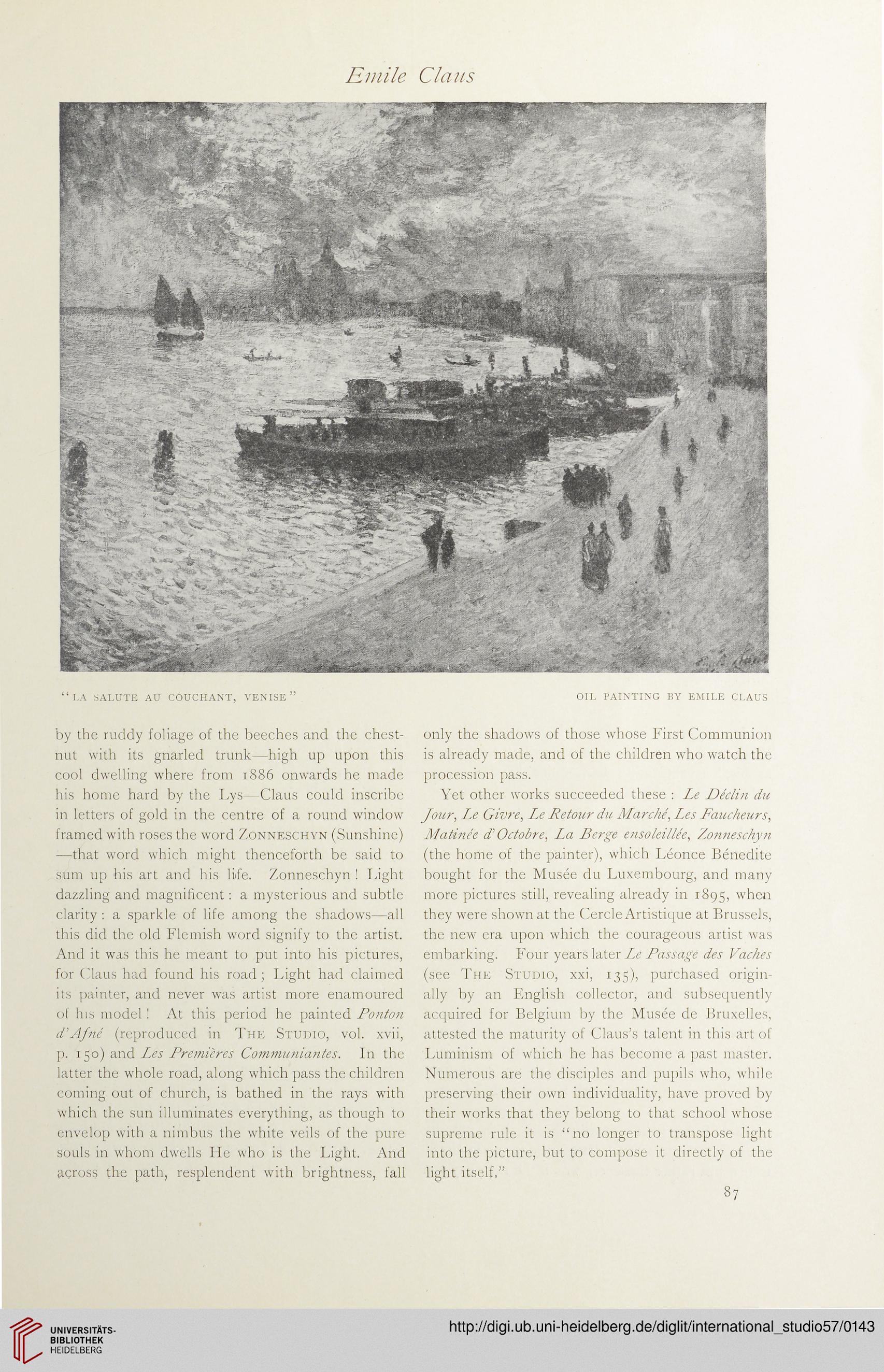Emile Claus
“LA SALUTE AU COUCHANT, VENISE ”
OIL PAINTING BY EMILE CLAUS
by the ruddy foliage of the beeches and the chest-
nut with its gnarled trunk—high up upon this
cool dwelling where from 1886 onwards he made
his home hard by the Lys—Claus could inscribe
in letters of gold in the centre of a round window
framed with roses the word Zonneschyn (Sunshine)
—that word which might thenceforth be said to
sum up his art and his life. Zonneschyn ! Light
dazzling and magnificent: a mysterious and subtle
clarity : a sparkle of life among the shadows—all
this did the old Flemish word signify to the artist.
And it was this he meant to put into his pictures,
for Claus had found his road; Light had claimed
its painter, and never was artist more enamoured
of his model! At this period he painted Ponton
d'Afnc (reproduced in The Studio, vol. xvii,
p. 150) and Les Premieres Communiantes. In the
latter the whole road, along which pass the children
coming out of church, is bathed in the rays with
which the sun illuminates everything, as though to
envelop with a nimbus the white veils of the pure
souls in whom dwells He who is the Light. And
across the path, resplendent with brightness, fall
only the shadows of those whose First Communion
is already made, and of the children who watch the
procession pass.
Yet other works succeeded these : Le Declin du
Jour, Le Givre, Le Retour du Marche, Les Faucheurs,
Matinee d' Octobre, La Berge ensoleillee, Zonneschyn
(the home of the painter), which Leonce Benedite
bought for the Musee du Luxembourg, and many
more pictures still, revealing already in 1895, when
they were shown at the Cercle Artistique at Brussels,
the new era upon which the courageous artist was
embarking. Four years later Le Passage des Vaches
(see The Studio, xxi, 135), purchased origin-
ally by an English collector, and subsequently
acquired for Belgium by the Musee de Bruxelles,
attested the maturity of Claus’s talent in this art of
Luminism of which he has become a past master.
Numerous are the disciples and pupils who, while
preserving their own individuality, have proved by
their works that they belong to that school whose
supreme rule it is “no longer to transpose light
into the picture, but to compose it directly of the
light itself,”
87
“LA SALUTE AU COUCHANT, VENISE ”
OIL PAINTING BY EMILE CLAUS
by the ruddy foliage of the beeches and the chest-
nut with its gnarled trunk—high up upon this
cool dwelling where from 1886 onwards he made
his home hard by the Lys—Claus could inscribe
in letters of gold in the centre of a round window
framed with roses the word Zonneschyn (Sunshine)
—that word which might thenceforth be said to
sum up his art and his life. Zonneschyn ! Light
dazzling and magnificent: a mysterious and subtle
clarity : a sparkle of life among the shadows—all
this did the old Flemish word signify to the artist.
And it was this he meant to put into his pictures,
for Claus had found his road; Light had claimed
its painter, and never was artist more enamoured
of his model! At this period he painted Ponton
d'Afnc (reproduced in The Studio, vol. xvii,
p. 150) and Les Premieres Communiantes. In the
latter the whole road, along which pass the children
coming out of church, is bathed in the rays with
which the sun illuminates everything, as though to
envelop with a nimbus the white veils of the pure
souls in whom dwells He who is the Light. And
across the path, resplendent with brightness, fall
only the shadows of those whose First Communion
is already made, and of the children who watch the
procession pass.
Yet other works succeeded these : Le Declin du
Jour, Le Givre, Le Retour du Marche, Les Faucheurs,
Matinee d' Octobre, La Berge ensoleillee, Zonneschyn
(the home of the painter), which Leonce Benedite
bought for the Musee du Luxembourg, and many
more pictures still, revealing already in 1895, when
they were shown at the Cercle Artistique at Brussels,
the new era upon which the courageous artist was
embarking. Four years later Le Passage des Vaches
(see The Studio, xxi, 135), purchased origin-
ally by an English collector, and subsequently
acquired for Belgium by the Musee de Bruxelles,
attested the maturity of Claus’s talent in this art of
Luminism of which he has become a past master.
Numerous are the disciples and pupils who, while
preserving their own individuality, have proved by
their works that they belong to that school whose
supreme rule it is “no longer to transpose light
into the picture, but to compose it directly of the
light itself,”
87




